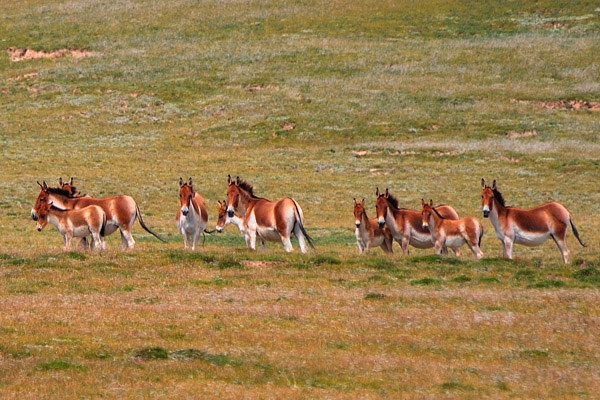TIBETAN WILD ASS
Equus kiang
Physical Description
The Tibetan Wild Ass, or Kiang, was until recently considered to be a subspecies of Equus hemionus, the Kulan or Asiatic Wild Ass. Though the Kiang is very similar to the Kulan, it is now recognized as a distinct species, Equus kiang. The Kiang has a reddish brown coat that darkens in color during the winter months. The Kiang’s legs, undersides, the insides of the ears, and the border around the Kiang’s grey muzzle are white.
The Kiang’s short mane, long, tufted tail, and the tips of the Kiang’s short ears are dark brown. The Kiang also has a dark dorsal stripe, which extends from its mane to its tail. The Kiang’s summer coat is short, sparse, and sleek in comparison to its longer, thicker winter coat.
The Kiang is the largest of the wild asses. The Kiang actually resembles a horse more than it does an ass, due to its small ears and long tail. The Kiang has a body length of approximately 210 centimetres (seven feet), a tail length of 50 centimetres (50 inches), and a shoulder height of 140 centimetres (4.6 feet).
The Kiang weighs about 250 to 400 kilograms (550 to 880 pounds). During August and September, the only months when the Kiang’s food sources are abundant, the Kiang may gain up to 45 kilograms (88 to 100 pounds) in weight.
Habitat
The Kiang inhabits plains, hills, basins, broad valleys, and other types of open terrain, at elevations from 2,700 to 5,300 metres (8,900 to 17,400 feet). The Kiang is most abundant in alpine meadows and alpine steppes, but also occurs in more arid habitats. The Kiang is only found on the Tibetan Plateau and the area just west of the Plateau. The Kiang’s habitat range includes Tibet and bordering areas of China, Pakistan, and India, including Ladakh and Sikkim. The Kiang’s population has become increasingly fragmented. Today, the Kiang is most densely distributed in protected areas and areas under army jurisdiction, including the Arjin Shan, Kalamaili Mountain, Chang Tang, and Chomo Langma (Qomolangma) Nature Reserves.
Eating Habits
The Kiang’s diet consists of grasses (Stipa spp.), sedges, and other low plants.
Behaviour and Reproduction
The Kiang is a strong swimmer and takes apparent pleasure in bathing in rivers during the summer months. The Kiang lives alone or in small herds. Herds are smallest in the summer and largest in the winter. Mares, accompanied by their foals or yearlings, tend to form herds with other mares that are in the same stage of reproduction. Stallions are more likely than mares to be solitary, especially during the rut season. During the rut, some stallions seem to be territorial, and others group mares into harems. Herds and solitary kiangs may congregate on good pastures during the fall and winter. Congregations of as many as a 1,000 kiangs have been spotted, but congregations of 100 to 300 kiangs are more common.
The Kiang probably reaches sexual maturity at about two to three years of age. Breeding and births take place in the summer months, from July to September, when the most forage is available. The Kiang’s gestation period is about 355 days, close to one year. Each mother gives birth to one foal, which may weigh about 30 kilograms (66 pounds) and stand about 90 centimetres (3 feet) tall at the shoulder. Foals are weaned within a year after birth and reach adult size soon after.
The Kiang may live for as long as 20 years, but most Kiang live to between 7 and 11 years of age. Young kiangs are susceptible to harsh weather conditions and many die during their first or second winter. Wolves are the Kiang’s main natural predators. Kiangs, especially the stallions, are quite curious animals, often watching the humans they encounter rather than fleeing from them.
Present Status
The Kiang is categorized as Lower Risk: Least Concern in the 2003 IUCN Red List of Threatened Species and is listed under Appendix II of CITES. The Kiang is under first class protection in China and is included in Schedule I, Part I of the Indian Wild Life (Protection) Act of 1972.
In the last few decades, the Kiang’s population has decreased significantly in size and has become fragmented.
Threats to Survival
Much of the northern part of the Kiang’s habitat has been degraded or lost entirely due to the establishment of significant mining and oil exploration operations in this region, and the incursion of the large populations needed to cater to the mines and the processing of minerals.
Pastoralists and their livestock have encroached upon other areas of the Kiang’s habitat. These livestock compete with the Kiang for water and forage and may carry diseases. Furthermore, because more and more pastoralists are “sedentary”, rather than nomadic, overgrazing is becoming a problem, and wild animals, such as the Kiang, are being fenced out of their traditional foraging areas. Intensifying the Kiang’s troubles, pastoralists, miners, oil workers, and others hunt the Kiang for food. New and improved roads provide easier access to previously isolated areas of the Kiang’s habitat range. The increased military presence on the border between Ladakh and Tibet that bisects the Chang Tang may also pose a threat to the Kiang.
References
Huffman, Brent, Kiang, Tibetan wild ass, http://www.ultimateungulate.com/Perissodactyla/Equus_kiang.html, Sept 2004.
Schaller, George B., 1998: Wildlife of the Tibetan Steppe, The University of Chicago Press, London.
Shah, Nita, Status and Action Plan for the Kiang (Equus kiang), http://www.iucn.org/themes/ssc/actionplans/equids/part2chapter6.pdf, Sept
2004.
Wang, H., 2002: Equus kiang, Animal Diversity Web, http://animaldiversity.ummz.umich.edu/site/accounts/information/
Equus_kiang.html, Sept 2004.
By: Environment and Development Desk, DIIR, CTA.



comment 0